Doc’s Guns
Some of Doc’s guns are lost to history. He most likely pawned some of his “jewelry” now and then as his fortunes declined. For example: his shootout with Billy Allen in Leadville, Colorado (08/19/1884) appears to have been with a borrowed gun. (Maybe a Thunderer?) Where is the Colt Lightning he used in Tombstone at the OK Corral? At one time, he was said to have owned a Henry rifle. Any Gun that could be reliably traced to Doc would be worth tens of thousands of dollars in today’s gun market (Here is that provenance* thing again).
In his 1994 “The Illustrated Life and Times of Doc Holliday” (p. 67), Bob Bose Bell presents a photo of an 1866 Remington Derringer (#474), engraved on the backstrap “To Doc From Kate”, which he notes as “allegedly given to Doc by Kate” (Mary Katherine Harony). I think, had he been able to see the provenance with the gun, he might have said more.
That gun has surfaced after many years in private hands, and has been purchased by the Glenwood Springs Historical Society for their museum in Glenwood Springs, CO.
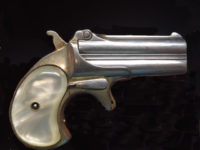
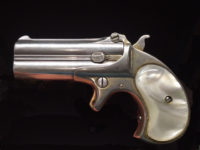
Remington Derringer #474, is marked on the backstrap : “To Doc from Kate”. In .41 rimfire: single action, spur trigger, superposed barrels with an oscillating firing pin which fired each barrel in turn. Apparently Remington did not serialize these guns. They are believed to be assembly numbers or series numbers. It is a Model 95, type two, “B” model (it has an extractor). A member of a group, manufactured sometime between 1866 and 1888. Remington records indicate that some 150,000 of these guns were manufactured between 1866 and 1934. Most blued, with walnut or hard rubber grips. Nickel plated models sported ivory or mother-of-pearl grips.
Short range with a small charge, but nasty up close. A backup gun and one commonly carried by the soiled doves.
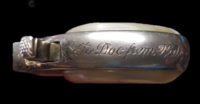
 Doc’s gun, shows the December 12th 1865 patent date,on top of the barrels, at the end of the second line. It is possible that this gun was
Doc’s gun, shows the December 12th 1865 patent date,on top of the barrels, at the end of the second line. It is possible that this gun was
manufactured as early as 1867 or ’68 but, in any case, there were 14 years of production before 1881 when most think she gave him the gun.
Did she buy it at Spangenburg’s gun shop on fourth street in Tombstone? Where else? Or did she already have it? We aren’t likely to answer most of these kinds of questions but it’s sure fun to speculate. The story says it was a gift to sooth over a big spat. Well, there was one. If I was guessing which fight, I’d say it was most likely the one around the Kinnear Stage robbery near Drew’s Station (03/15/1881)*. She certainly got him in hot water over that one. JP Wells Spicer had tossed the case after Kate repudiated her “confession”, which had been obtained by Sheriff Johnny Behan while she was drunk and angry with Doc. The public comment attributed to Doc on the whole thing, after he was cleared of the hold-up (07/09/1881), went like this: “If I had robbed that stage, I’d have got the $80,000.”
Doc B.
all of the above photos of Doc’s 1866 Remington Derringer – 2016, courtesy Jason Brierly.
*Here is the event as noted in Old West Daily Reader:
3/15 of… 1881
(T) An attempt is made to rob The Kinnear Stage near Drew’s Station, AZ. Driver Bud Philpot and miner Peter Roerig are killed. Messenger Bob Paul wounds one of the bandits, (Leonard) and eventually stops the runaway team. Luther King is arrested by the pursuing posse and identifies the bandits as Bill Leonard, Harry Head and Jim Crane, then, he is soon allowed to escape by Behan under-sheriff Harry Woods. Later, Sheriff Behan is almost able to frame Doc Holliday for the incident.
Some of the Provenance
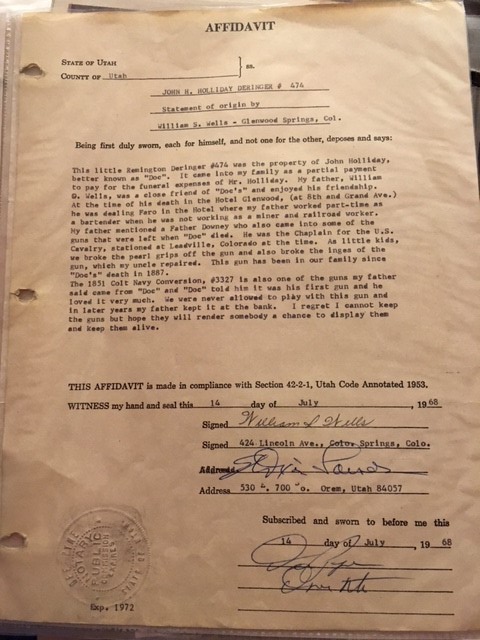
Cropped and photo-shopped by Doc B.
We think that Wells and Larson likely created this document together,
to serve as provenance for Larson when he purchased both of these guns,
at the same time, from the Wells family.
 In the above affidavit associated with the Remington Derringer, you can see that two other Doc Holliday Guns are mentioned: an 1851 Navy Colt and a shotgun.
In the above affidavit associated with the Remington Derringer, you can see that two other Doc Holliday Guns are mentioned: an 1851 Navy Colt and a shotgun.
I will mention the the shotgun first. We don’t know the make, and the serial number is not included in this document, nor any other, in the provenance package with the derringer. We have only this photograph, a few facts and some 1972 historic hyperbole in the magazine article included in the provenance packet. This old mule ear looks to be a 12 bore, might be a 10, it’s a hand full if it is. It’s sawed off on both ends, the stock, short to make a pistol grip and the barrels are likely shortened well under 20 inches. This photo does not answer that question. A lanyard ring has been added to suspend the gun in the armpit under a coat. Not exactly something one sits comfortably with at a gambling table for the evening. More likely a gun for traveling and other business. This gun went a different direction from Dixon Larson, the 1866 Remington derringer and the 1851 Navy Colt. However, our diligent provenance research team has followed this guns trail from Father Art Downey in 1887 Glenwood Springs, and we are currently aware of the identity of the modern owner, thus the guns location. This was a nice additional verification of the derringers provenance.
There is a faction who believe that this is the OK Corral shotgun used by Doc to kill Tom McLaury. I will likely have more to say about that at a later date. – Doc B.
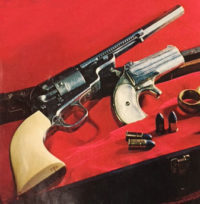 So, now we come to the 1851 Navy Colt (.36 cal. percussion). We knew Doc had one. It came to Doc from his uncle, John Stiles Holliday, who had given one to each of his three sons and one to brother Henry’s boy, cousin John Henry. There is photo of Doc’s cousin Robert’s Colt Navy in Karen Holliday Tanner’s 1972 “Doc Holliday” (p. 70). The photo identifies the gun as a third model, leaving most everyone thinking that the other three, including Doc’s probably were as well. However, the affidavit describes Doc’s gun as a “conversion”, also giving us its serial number as #3327, which then identifies it as a early second model. It does not say whether the Rollin White (Patent 1855) conversion was to rimfire or centerfire. Therefore, it should have the square back trigger guard seen on my modern Second Model ’51 Navy in the article below, and, as with all 1851 Navy conversions, the revolver is now a .38. But, clearly the piece doesn’t have a square back trigger guard in the photo at left. Why not?
So, now we come to the 1851 Navy Colt (.36 cal. percussion). We knew Doc had one. It came to Doc from his uncle, John Stiles Holliday, who had given one to each of his three sons and one to brother Henry’s boy, cousin John Henry. There is photo of Doc’s cousin Robert’s Colt Navy in Karen Holliday Tanner’s 1972 “Doc Holliday” (p. 70). The photo identifies the gun as a third model, leaving most everyone thinking that the other three, including Doc’s probably were as well. However, the affidavit describes Doc’s gun as a “conversion”, also giving us its serial number as #3327, which then identifies it as a early second model. It does not say whether the Rollin White (Patent 1855) conversion was to rimfire or centerfire. Therefore, it should have the square back trigger guard seen on my modern Second Model ’51 Navy in the article below, and, as with all 1851 Navy conversions, the revolver is now a .38. But, clearly the piece doesn’t have a square back trigger guard in the photo at left. Why not?
The magazine article tells all… the conversion was to centerfire and we can see the revolvers own serial number 3327, forward of the trigger guard. It seems likely that when the conversion was done, the hammer modified for centerfire, the cylinder bored out to .38 and machined to take metallic cartridges, the ramrod removed and the standard Colt extractor added under the right side of the barrel, they also changed the trigger guard. They did too, because the serial number on it, is five digits, not a match. The gun is nickel plated with ivory grips. Various marks and such on the museum’s 1866 Remington derringer #474 are readily identifiable in the photo. All of this from a 1972 article in the 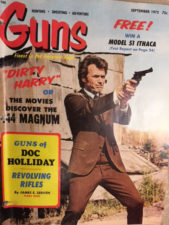 September issue of Guns magazine. Placed by Utah gun dealer Dixon Larson, who was the purchaser of both guns in 1968.
September issue of Guns magazine. Placed by Utah gun dealer Dixon Larson, who was the purchaser of both guns in 1968.
Colt’s records for this gun were among those destroyed when the factory was burned by the Confederates in 1861. We don’t who had the Gun modified or where or when, but I rather suspect that it was Doc because he needed to use it and it needed to be “modernized” to use metallic cartridges.
The Museum Provenance Team has not yet discovered the location or current owner of this firearm. None-the-less, the association with this Colt Navy, the photographs and letters (not shown here) all help fill out a broad and interesting provenance for the derringer. – Doc B.
see:
Provenance
The conversion of Doc’s 1851 Colt Navy per the Rollin White patent of 1855.
Left: Two 1851 Navy Colts (c. 1863), Top: Standard factory .36 cal. cap-and-ball, unmodified. Below: Richards-Mason conversion originally .38 rimfire, later converted to centerfire and the barrel shortened (c. 1874) Right: Two c. 1861 Navy Colts; on top is a standard .36 cal percussion. and under it is a Richards- Mason conversion to .38 centerfire. Photos: U.S. © Mike Long, OWDR contributor # 007.
The four revolvers shown above are particularly interesting because they represent a time of great transition in firearms technology. A huge gain in convenience, speed of use (reloading) and therefore firepower from a single gun. Also, there was a great reduction in the accessory equipment required to maintain and use the weapon. All four of these guns began life as front loading cap and ball revolvers like the unmodified ones (top). The bottom two were converted to metallic cartridges. Also note the added extractors. The revolver ( left above, bottom) was converted twice. First to rimfire and then to centerfire; a clear demonstration of how fast the technology was moving. As you can see, this one is the same as Doc’s conversion but I think this one was a third model in the first place, no trigger guard change needed to get this look.
Which firearms were known to have been used
by Doc Holliday?
Doc’s other guns, shown below are the “right” guns,
like those he actually used; they’re just not Doc’s guns.
The Hand Guns
 An 1851 Colt Navy (.36 cal. blackpowder, percussion), was probably the second handgun in Doc’s life. We know Henry Burroughs Holliday had one and later Uncle John (Dr. John Stiles Holliday) gave one to each Doc and and his cousin Robert (1872). His first gun may well have been grandfather Robert’s revolutionary war, single shot flintlock pistol. However, we can easily believe that it was dad’s Navy, that made Doc a marksman. One of the most reliable, accurate and best of the early percussion repeating pistols. Wild Bill Hickok carried a brace (2) of these fine guns. This one is modern, one of the series made by Colt when they began a commemorative production of the piece again. Photo: R.W. Doc Boyle, a performance gun.
An 1851 Colt Navy (.36 cal. blackpowder, percussion), was probably the second handgun in Doc’s life. We know Henry Burroughs Holliday had one and later Uncle John (Dr. John Stiles Holliday) gave one to each Doc and and his cousin Robert (1872). His first gun may well have been grandfather Robert’s revolutionary war, single shot flintlock pistol. However, we can easily believe that it was dad’s Navy, that made Doc a marksman. One of the most reliable, accurate and best of the early percussion repeating pistols. Wild Bill Hickok carried a brace (2) of these fine guns. This one is modern, one of the series made by Colt when they began a commemorative production of the piece again. Photo: R.W. Doc Boyle, a performance gun.
 This unusual firearm is a Le Mat Revolver from the Civil War era. Confederate Generals P.G.T. Beauregard, J.E.B. Stuart, Doc’s father, Henry, and others carried LeMat revolvers. This one is a genuine late model in pinfire. The originals (1856-65) were French made and ran the Union blockade to get into Confederate America. In .35; 36; 42 & .44 cal percussion, nine shots in the cylinder and a 16 ga. shotgun as the cylinder shaft. All an attempt to add firepower when it wasn’t practical to reload in “adverse” conditions. A large, barrel heavy, awkward gun and not terribly powerful but that last shot with buck and ball was a big one. This gun sports a lanyard ring, supposedly identifying it as the cavalry version. Never made in large quantities [est. 2,900] and even then, not all got past the blockades so they are rare and very expensive in the today’s collectors market. A few came west. I’d bet Doc shot dad’s. I have a modern replica I use for performance. Photo: U.S. PD U.S. Gov.
This unusual firearm is a Le Mat Revolver from the Civil War era. Confederate Generals P.G.T. Beauregard, J.E.B. Stuart, Doc’s father, Henry, and others carried LeMat revolvers. This one is a genuine late model in pinfire. The originals (1856-65) were French made and ran the Union blockade to get into Confederate America. In .35; 36; 42 & .44 cal percussion, nine shots in the cylinder and a 16 ga. shotgun as the cylinder shaft. All an attempt to add firepower when it wasn’t practical to reload in “adverse” conditions. A large, barrel heavy, awkward gun and not terribly powerful but that last shot with buck and ball was a big one. This gun sports a lanyard ring, supposedly identifying it as the cavalry version. Never made in large quantities [est. 2,900] and even then, not all got past the blockades so they are rare and very expensive in the today’s collectors market. A few came west. I’d bet Doc shot dad’s. I have a modern replica I use for performance. Photo: U.S. PD U.S. Gov.
see also in Old West Daily Reader:
Photo Gallery – Weapons Photos – Handguns – Le Mat Revolver
 Colt 1877 Lightning*with a birds head grip, .38 cal., six shots. A wise man only loaded five and carried the piece hammer down on the empty cylinder. The weapon will definitely fire if the hammer is bumped hard enough; such as being dropped. This was the first commercially successful double action pistol, a “self cocker” as the old timers called it. Meaning that one could pull the trigger and the guns mechanism rotated the cylinder, cocked the hammer and dropped it, firing the round. A fine little gun but the internal parts were a bit delicate. Its big brother, the Thunderer was somewhat larger and in .41 cal. They might or might not have a Colt style under barrel extractor. Barrel lengths from 2″ to 6″. The “nickel plated shooter” wielded by Doc Holliday, that the cowboys reported to Judge Spicer after the “Streetfight in Tombstone**”, as the local citizenry described it, was a Lightning. This was the only one of Doc’s guns to figure in the event. Photo: R.W. “Doc” Boyle; This is one of my performance guns, serial no. 24024 built in 1882.
Colt 1877 Lightning*with a birds head grip, .38 cal., six shots. A wise man only loaded five and carried the piece hammer down on the empty cylinder. The weapon will definitely fire if the hammer is bumped hard enough; such as being dropped. This was the first commercially successful double action pistol, a “self cocker” as the old timers called it. Meaning that one could pull the trigger and the guns mechanism rotated the cylinder, cocked the hammer and dropped it, firing the round. A fine little gun but the internal parts were a bit delicate. Its big brother, the Thunderer was somewhat larger and in .41 cal. They might or might not have a Colt style under barrel extractor. Barrel lengths from 2″ to 6″. The “nickel plated shooter” wielded by Doc Holliday, that the cowboys reported to Judge Spicer after the “Streetfight in Tombstone**”, as the local citizenry described it, was a Lightning. This was the only one of Doc’s guns to figure in the event. Photo: R.W. “Doc” Boyle; This is one of my performance guns, serial no. 24024 built in 1882.
 *This heavy little fellow is an 1866 Remington Derringer in .41 rimfire; single action, spur trigger, superposed barrels with an oscillating firing pin which fired each barrel in turn. Apparently Remington did not serialize these guns. This one is #23, but that is an assembly number, not a serial number. It is a Model 95, type two, “B” model (it has an extractor), manufactured sometime between 1866 and 1888. Remington records indicate that some 150,00 of these guns were manufactured between 1866 and 1934. Most blued, with walnut or hard rubber grips, nickel plated models sported ivory or mother-of-pearl grips. Short range with a small charge, but nasty up close. A backup gun and one commonly carried by the the soiled doves. Kate was said to have given one of these (#474) to Doc (proven true! see: above!) Photo: R.W. “Doc” Boyle, This one is one of my performance guns.
*This heavy little fellow is an 1866 Remington Derringer in .41 rimfire; single action, spur trigger, superposed barrels with an oscillating firing pin which fired each barrel in turn. Apparently Remington did not serialize these guns. This one is #23, but that is an assembly number, not a serial number. It is a Model 95, type two, “B” model (it has an extractor), manufactured sometime between 1866 and 1888. Remington records indicate that some 150,00 of these guns were manufactured between 1866 and 1934. Most blued, with walnut or hard rubber grips, nickel plated models sported ivory or mother-of-pearl grips. Short range with a small charge, but nasty up close. A backup gun and one commonly carried by the the soiled doves. Kate was said to have given one of these (#474) to Doc (proven true! see: above!) Photo: R.W. “Doc” Boyle, This one is one of my performance guns.
The Long Guns
![]() This is an Italian Replica (Uberti) of the original 1862 Henry Rifle. This is the military version, it has sling attachments. This modern rifle is in 44-40, the original was .44 Henry rimfire. Note that the Henry lacks both a wooden fore end and the loading port of the later generation Winchesters. This rifle has a much longer barrel than the carbines below; not so convenient on horseback. Doc was known to have carried a Henry on occasion. Well preserved Henry’s bring big prices today. Photo: R.W. “Doc” Boyle; one of my performance guns. {001}
This is an Italian Replica (Uberti) of the original 1862 Henry Rifle. This is the military version, it has sling attachments. This modern rifle is in 44-40, the original was .44 Henry rimfire. Note that the Henry lacks both a wooden fore end and the loading port of the later generation Winchesters. This rifle has a much longer barrel than the carbines below; not so convenient on horseback. Doc was known to have carried a Henry on occasion. Well preserved Henry’s bring big prices today. Photo: R.W. “Doc” Boyle; one of my performance guns. {001}
Children of the Henry; the wonderful Winchesters
 Here’s two: An 1866 “Yellow Boy”, this one is a Model 2 Carbine in .44 rimfire, # 76942 (1871). Lighter and shorter than the rifles, these guns have a “saddle rings” but were usually carried in a scabbard along side the horse maybe under the fender (short distance; guns carried under the fender on a long haul chafe the horse.) with the butt forward and often high on the horse’s neck; not butt to the rear as seen in so many western movies. Sagebrush and other things pull weapons carried in that fashion and leave them on the ground and they can’t be conveniently reached from the saddle. This wasn’t one of Doc’s guns and I know of no “evidence” of Doc ever using a ’66, but he may well have done so sometime, as they were certainly around.
Here’s two: An 1866 “Yellow Boy”, this one is a Model 2 Carbine in .44 rimfire, # 76942 (1871). Lighter and shorter than the rifles, these guns have a “saddle rings” but were usually carried in a scabbard along side the horse maybe under the fender (short distance; guns carried under the fender on a long haul chafe the horse.) with the butt forward and often high on the horse’s neck; not butt to the rear as seen in so many western movies. Sagebrush and other things pull weapons carried in that fashion and leave them on the ground and they can’t be conveniently reached from the saddle. This wasn’t one of Doc’s guns and I know of no “evidence” of Doc ever using a ’66, but he may well have done so sometime, as they were certainly around.
![]() The Model 1873 featured the same design but now the receiver was steel instead of brass. This one (also a carbine) is a nice old example of “The Gun That Won The West!”; in 44-40 centerfire, it is a Model 1, #95551A (1882). Other cartridges were introduced for the ’73 in later years but the design was inherently too weak and short of throw to handle anything larger than pistol cartridges (and, hopefully, black powder at that). None the less, the Model 1866 was produced until 1898 and the Model 1873 until 1919. We don’t know if one of these numbered among Doc’s guns, but we know he used them. Doc told Ike Clanton, the night before the OK gunfight, that he had killed Newman Hayes “Old Man” Clanton* (Ike’s father) with one of these (a rifle) at Skeleton (Guadalupe) Canyon. Both photos R.W. “Doc” Boyle; both “Doc” performance guns.
The Model 1873 featured the same design but now the receiver was steel instead of brass. This one (also a carbine) is a nice old example of “The Gun That Won The West!”; in 44-40 centerfire, it is a Model 1, #95551A (1882). Other cartridges were introduced for the ’73 in later years but the design was inherently too weak and short of throw to handle anything larger than pistol cartridges (and, hopefully, black powder at that). None the less, the Model 1866 was produced until 1898 and the Model 1873 until 1919. We don’t know if one of these numbered among Doc’s guns, but we know he used them. Doc told Ike Clanton, the night before the OK gunfight, that he had killed Newman Hayes “Old Man” Clanton* (Ike’s father) with one of these (a rifle) at Skeleton (Guadalupe) Canyon. Both photos R.W. “Doc” Boyle; both “Doc” performance guns.
Street Howitzers (Wyatt Earp)
 This is a black powder, 12 bore, mule ear (the hammers), coach gun; aka. sawed off shotgun. Guns such as this were often carried by various kinds of express guards on wagons, stagecoaches and trains. The barrels are about 20 inches long. The front trigger is the right barrel the rear the left. Often loaded with Buckshot (00 Buck is .33 in., nine in 12 ga.).They are powerful, handy and deadly. The cowboys said, “A pistol means a shootin’. A shotgun means a buryin’!” Wyatt Earp called them “street howitzers”. Virgil Earp traded Doc a cane for a double barrel shotgun (thought to possibly have been a Wells-Fargo 10 bore) when Doc arrived at Hafford’s corner shortly before the Gunfight at the OK Corral. Not one of Doc’s guns, definitely a loaner. It was this gun that Doc would use to kill Tom McLaury. It would have looked very much like this one. This shotgun, while almost one hundred years old and sporting laminated (Damascus) steel barrels; still can’t compare to the real western antiques of the 1880’s even though it looks just like them and works exactly the same way. This imported 1920’s gun is Belgian made (W. Richards) and like most such guns began life as a hunter with barrels of perhaps 30″ or more. This is a Doc performance gun and I do shoot light blanks in it . Photo: R.W. “Doc” Boyle. {001}
This is a black powder, 12 bore, mule ear (the hammers), coach gun; aka. sawed off shotgun. Guns such as this were often carried by various kinds of express guards on wagons, stagecoaches and trains. The barrels are about 20 inches long. The front trigger is the right barrel the rear the left. Often loaded with Buckshot (00 Buck is .33 in., nine in 12 ga.).They are powerful, handy and deadly. The cowboys said, “A pistol means a shootin’. A shotgun means a buryin’!” Wyatt Earp called them “street howitzers”. Virgil Earp traded Doc a cane for a double barrel shotgun (thought to possibly have been a Wells-Fargo 10 bore) when Doc arrived at Hafford’s corner shortly before the Gunfight at the OK Corral. Not one of Doc’s guns, definitely a loaner. It was this gun that Doc would use to kill Tom McLaury. It would have looked very much like this one. This shotgun, while almost one hundred years old and sporting laminated (Damascus) steel barrels; still can’t compare to the real western antiques of the 1880’s even though it looks just like them and works exactly the same way. This imported 1920’s gun is Belgian made (W. Richards) and like most such guns began life as a hunter with barrels of perhaps 30″ or more. This is a Doc performance gun and I do shoot light blanks in it . Photo: R.W. “Doc” Boyle. {001}
Doc certainly would have used a number of other firearms. The .41 Colt Thunderer comes to mind as well as various other Remington and Colt models. We just don’t know if he owned any of them. Unlikely, as the big handguns were too awkward when seated at a table for long stretches of time. Of the two times we know he used a shotgun, they were loaners. The Henry rifle may well have been his. If there’s one thing I’ve noticed about outlaws, lawmen and express guards; they all continuously updated their firearms right along with the technology; often, easily outstripping the military. And, of course, so did the Indians. Custer’s troopers* would have had a lot say about the firepower difference between single shot trap-door Springfields (copper cartridges aside) and lever action repeating Henrys and Winchesters. Although 30 minutes wouldn’t have been a lot of time to delve into it. Doc was working at The Bella Union Variety in Cheyenne, Wyoming about then. He like everyone else would not have heard about Custer until after the Yellowstone River steamboat Far West, it’s whistle blaring, arrived in Bismark, North Dakota near midnight** and the world learned by telegraph what had occurred at the Little Bighorn.
see also in Doc Holliday Live:
Doc Photos
Doc Holliday New Photo
Doc Quotes
Provenance – Guns & Photos
A new Doc gun?
Possibly, but not too likely. A gentleman brought a gun into the Glenwood Springs Historical Museum, alleging it had come frome the hand of Doc Holliday via Art Kendrick, Doc’s bellhop in 1887. Here are some photos of the gun. (working on ’em, 07/20/2017) – Doc

For those with a further interest in the firearms: On my subscription Western History website, Old West Daily Reader*, I outline some of the technology changes taking place in the times of the old west, from early percussion to center fire metallic cartridges.** Aided by photos, provided by collector/contributors in the U.S. and abroad, the progression in guns and ammunition is clearly visible in the photos. Also presenting more than 200 photos of Old West firearms and other weapons of the frontier.
for related information on this subject in Old West Daily Reader:
**Photo gallery Index – Weapons Photos Index- Ammunition, Then and Now
Photo Gallery Index – Weapons Photos Index – Mike’s Revolvers Page 1
Photo gallery Index – Weapons Photos Index- Mike’s Revolvers P.2
Photo Gallery Index – Weapons Photos Index – Handguns
Photo Gallery Index – Weapons Photos Index – Marcel’s Guns
Photo Gallery Index – Weapons Photos Index – Firearms Oddities
OWDR Wk. 14, 04/03/1855 – Rollin White
and also in Old West Daily Reader:
PLAYERS – Timelines Index – Timelines A-L – Wild Bill Hickok Timeline
Photo Gallery Index – Cowboy Photos – Grabil’s “Cowboy”
Wk. 09, 03/02/1866 – 1866 “Yellow Boy”
Wk. 32, 08/12/1881 – “Old Man” Clanton
Wk. 50, 12/11/1880 – Oliver Winchester
Wk. 26, 06/25/1876 – Little Bighorn
Wk. 27, 07/05/1876 – Bismark, ND
*Old West Daily Reader
is a subscription site, $20 U.S. per year (via PayPal)
14 day money back trial period.
Take a look, and please leave me a Facebook “Like ” as your ride by.
Don’t miss History Riders Radio™ – 52 shows – FREE on the front page.
www.oldwestdailyreader.com
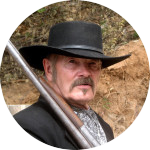
 End: Doc’s Guns
End: Doc’s Guns

